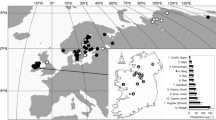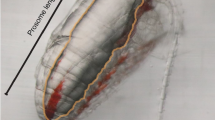Abstract
Life history patterns of the meiobenthic harpacticoid copepod Microarthridion littorale (Poppe) differed between intertidal and subtidal sites in a South Carolina, USA estuarine salt-marsh system. Throughout the summer and fall, densities of M. littorale were significantly greater intertidally than subtidally; however, for the remainder of the year the population sizes were not statistically different. Maximum densities occurred intertidally in July and subtidally in October. The number of eggs · gravid female-1 was significantly greater subtidally than intertidally at all times. The mean length of all adults increased from summer to spring and was similar between areas. Birth rates and death rates paralleled one another in each area and with the exception of August, birth rates were higher subtidally than intertidally. Juvenile mortality appeared highest subtidally, the mortality apparently occurring in the early naupliar stages. The variation in life history patterns across the tidal gradient was likely the result of differences in food quality and quantity, increased exposure to potential epibenthic predators subtidally, and to differential competitive pressure in the 2 areas.
Similar content being viewed by others
Literature Cited
Allan, J. D.: Competition and the relative abundances of two cladocerans. Ecology 54, 484–498 (1973)
Bell, S. S.: Meiofauna-macrofauna interactions in a high salt marsh habitat. Ecol. Monogr. (In press)
Bell, S. S., and B. C. Coull: Field evidence that shrimp predation regulates meiofauna. Oecologia (Berl.) 35, 141–148 (1978)
Brown, T. J., and J. R. Sibert: Food of some benthic harpacticoid copepods. J. Fish. Res. Bd Can. 34, 1028–1031 (1977)
Buchanan, J. B., and J. M. Kain: Measurement of the physical and chemical environment. In: IBP Handbook No. 16: Methods for the study of marine benthos, pp 30–58. Ed. by N. A. Holme and A. D. McIntyre. Oxford: Blackwell Scientific Publications 1971
Cole, L. C.: The population consequences of life history phenomena. Quart. Rev. Biol. 29, 103–137 (1954)
Coull, B. C.: Estuarine meiofauna: a review, trophic relationships and microbial interactions. In: Estuarine microbial ecology, pp 499–511. Ed. by L. H. Stevenson and R. R. Colwell. Columbia: University of South Carolina Press 1973
Deevey, G. B.: Relative effects of temperature and food on seasonal variations in length of marine copepods in some Eastern American and Western European waters. Bull. Bingham Oceanogr. Coll. 17, 54–85 (1960)
deJonge, V. N., and L. A. Bouwman: a simple density separation technique for quantitative isolation of meiobenthos using the colloidal silica Ludox-TM. Mar. Biol. 42, 143–148 (1977)
Edmondson, W. T.: Reproductive rates of rotifers in natural populations. Mem. Inst. Itl. Idrobiol. 12, 21–77 (1960)
Edmondson, W. T.: A graphical model for evaluating the use of the egg ratio for measuring birth and death rates. Oecologia (Berl.) 1, 1–39 (1968)
Elmgren, R.: Methods of sampling sublittoral soft bottom meiofauna. Oikos Suppl. 15, 112–120 (1973)
Feller, R. J.: Quantitiative cohort analysis of a sand-dwelling meiobenthic harpacticoid copepod. Est. Cstl. Mar. Sci. (In press)
Feller, R. J., and V. W. Kaczynski: Size-selective predation by juvenile chum salmon (Onocorhynchus keta) on epibenthic prey in Puget Sound. J. Fish. Res. Bd Can. 32, 1419–1429 (1975)
Fenchel, T. M.: The ecology of micro-and meiobenthos. Ann. Rev. Ecol. Syst. 9, 99–121 (1978)
Fisher, R. A.: The genetical theory of natural selection. 291 pp. London: Oxford University Press 1930
Fleeger, J. W.: Population dynamics of three estuarine meiobenthic harpacticoids (Copepoda) in South Carolina. Mar. Biol. 52, 147–156 (1979)
Fleeger, J. W.: Community structure of an estuarine meiobenthic copepod assemblage. Est. Cstl. Mar. Sci. 10, 107–117 (1980)
Heip, C., and N. Smol: On the importance of Protohydra leuckarti as a predator of meiobenthic populations. pp 285–296. In: Proceedings of the Tenth European Marine Biology Symposium, Vol. 2, Belgium: Universa Press 1976
Hirshfield, M. F. and D. W. Tinkle: Natural selection and the evolution of reproductive effort. Proc. Nat. Acad. Sci. 72, 2227–2231 (1975)
Inman, D. L.: Measures for describing the size distribution of sediments. J. Sed. Petrol. 22, 125–145 (1952)
Lack, D.: The significance of clutch-size, Parts 1 and 2. Ibis. 89, 302–352 (1947)
Lasker, R., J. B. J. Wells, and A. D. McIntyre: Growth, reproduction, respiration, and carbon utilization of the sanddwelling harpacticoid copepod Asellopsis intermedia. J. mar. biol. Ass. U.K. 50, 147–160 (1970)
Lee, J. J., J. H. Tietjen, and J. R. Garrison: Seasonal switching in the nutritional requirements of Nitocra typica, a harpacticoid copepod from salt marsh aufwuchs communities. Trans. Amer. Micros. Soc. 95, 628–637 (1976)
Lee, J. J., J. H. Tietjen, C. Mastropaolo, and H. Rubin: Food quality and the heterogenous spatial distribution of meiofauna. Helgoland. Wiss. Meeres. 30, 272–282 (1977)
Odum, E. P., and A. A. de la Cruz: Particulate organio detritus in a Georgia salt marsh-estuarine ecosystem. In: Estuaries pp 383–388. Ed. by G. H. Lauff. Washington: AAAS Publication 83, 1967
Palmer, M. A., and B. C. Coull: The prediction of development rate and the effect of temperature for the meiobenthic copepod Microarthridion littorale (Poppe). J. exp. mar. Biol. Ecol. 48, 73–83 (1980)
Pezzack, D. S., and S. Corey: The life history and distribution of Neomysis americana (Smith) (Crustacea, Mysidacea) in Passamaquoddy Bay. Can. J. Zool. 57, 785–793 (1979)
Pianka, E. R.: On “r” and “k” selection. Am. Natur. 104, 592–597 (1970)
Pomeroy, L. R., K. Bancroft, J. Breed, R. R. Christian, D. Frankenberg, J. R. Hall, L. B. Maurer, W. J. Wiebe, R. G. Wiegert, and R. L. Wetzel: Flux of organic matter through a salt marsh. In: Estuarine processes. Vol. 2, pp. 270–279. Ed. by M. L. Wiley. New York: Academic Press 1976
Prepas, E., and F. H. Rigler: The enigma of Daphnia death rates. Limnol. Oceanogr. 23, 970–988 (1978)
Sibert, J., T. J. Brown, M. C. Healy, B. A. Kask, and R. J. Naiman: Detritus-based food webs: exploitation by juvenile chum salmon (Oncorhynchus keta). Science, N. Y. 196, 649–650 (1977)
Spight, T. M., and J. Emlen: Clutch sizes of two marine snails with a changing food supply. Ecology 57, 1161–1178 (1976)
Stearns, S. C.: Life-history tactics: a review of the ideas. Quart. Rev. Biol. 51, 3–45 (1976)
Van Dolah, R. F., L. E. Shapiro, and C. P. Rees: Analysis of an intertidal population of the amphipod Gammarus palustris using a modified version of the egg ratio method. Mar. Biol. 33, 323–330 (1975)
Author information
Authors and Affiliations
Additional information
Communicated by J. M. Lawrence, Tampa
Rights and permissions
About this article
Cite this article
Palmer, M.A. Variation in life-history patterns between intertidal and subtidal populations of the meiobenthic copepod Microarthridion littorale . Marine Biology 60, 159–165 (1980). https://doi.org/10.1007/BF00389159
Accepted:
Issue Date:
DOI: https://doi.org/10.1007/BF00389159




